BIRDS. BEES. BUTTERFLIES.
They add color and joy to our lives, but more than that, they are an indispensable part of the food chain.
These small, hardworking, creatures give us the food we eat by pollinating home gardens as well as more than 100 farm crops that sustain 90% of the human population. Our economy, too, is therefore linked to their survival.
But the winged creatures that do so much for us are under stress from:
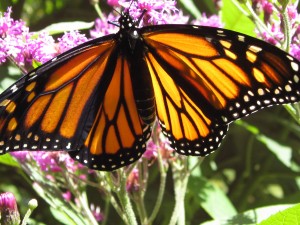 Chemicals: We have added to our environment hundreds of toxins which harm pollinator nervous systems and are suspected to contribute to Colony Collapse Disorder that has devastated the honeybee population in recent years.
Chemicals: We have added to our environment hundreds of toxins which harm pollinator nervous systems and are suspected to contribute to Colony Collapse Disorder that has devastated the honeybee population in recent years.
Habitat loss: Replacing open fields where wildflowers grow with buildings, roads, manicured lawns and unnatural gardens has removed living space and food sources for pollinators.
To lend pollinators a hand, the Catskill Mountains Scenic Byway
has hung out the welcome sign! Click here to read about the launch of this effort on the Byway.
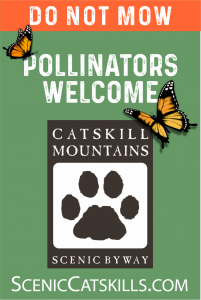 HERE’S HOW YOU CAN HELP:
HERE’S HOW YOU CAN HELP:
Plant for the pollinators. Download this list of flowers, bushes, trees and vines for native gardening in the Catskills. Keep your yard and garden organic. Shop carefully for seeds – ask the vendor if they contain neonicotinoids, an herbicide used to treat many mass-produced vegetable and flower seeds. It is deadly to bees and butterflies.
CATSKILLS NATIVE PLANT LIST
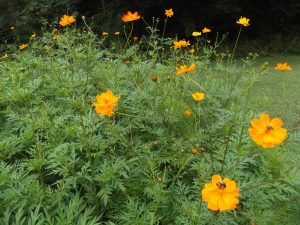 Don’t mow! Allow weeds and wildflowers to grow until they finish flowering to provide much needed nectar for pollinators. Dandelions, for example, are one of the season’s earliest food sources for bees. Milkweeds are an important food source and nursery for the threatened Monarch butterfly. Download a colorful poster of Milkweeds of the Northeast.
Don’t mow! Allow weeds and wildflowers to grow until they finish flowering to provide much needed nectar for pollinators. Dandelions, for example, are one of the season’s earliest food sources for bees. Milkweeds are an important food source and nursery for the threatened Monarch butterfly. Download a colorful poster of Milkweeds of the Northeast.
MILKWEEDS OF THE NORTHEAST
Avoid insecticides, herbicides and chemical fertilizers. Most herbicides contain glyphosate, which is harmful to butterflies, bees, and other pollinators. It is also indicated as a carcinogen for humans. The Woodstock Pollinator Pathway website has helpful information about the use of insecticides and their impact on pollinators.
PESTICIDE FREE ALTERNATIVES
Become a citizen scientist. Learn about invasive plants and insects that are altering our eco-system. You might want to sign on as a spotter with the Catskill Regional Invasive Species Partnership.
Be inspired. Visit Maralene Manos-Jones’ Spirit of Butterflies Website to see how she has been lobbying, educating and actively working to save the Monarch butterfly in the Catskills, the Hudson Valley and in Mexico. About Maraleen Manos-Jones
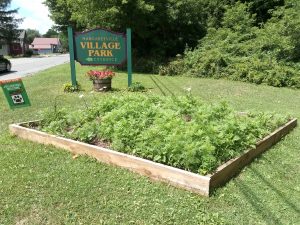 Be aware of public initiatives to help pollinators. The NYS Department of Transportation is considering guidelines for NYS Byways that would adjust mowing schedules and improve pollinator access to flowering plants. The NYC Department of Environmental Protection has revised mowing protocols on city lands in the NYC Watershed to as much as possible avoid cutting weeds and wildflowers before they flower, and to preserve milkweed, which Monarchs in particular rely on for food and habitat. Local officials, too, are urged to consider what they might do to help pollinators in their communities. Click here to view the Mayor’s Monarch Pledge.
Be aware of public initiatives to help pollinators. The NYS Department of Transportation is considering guidelines for NYS Byways that would adjust mowing schedules and improve pollinator access to flowering plants. The NYC Department of Environmental Protection has revised mowing protocols on city lands in the NYC Watershed to as much as possible avoid cutting weeds and wildflowers before they flower, and to preserve milkweed, which Monarchs in particular rely on for food and habitat. Local officials, too, are urged to consider what they might do to help pollinators in their communities. Click here to view the Mayor’s Monarch Pledge.
Got a few minutes? Check out Catskill Mountainkeeper’s “Save the Pollinators,” a short film that highlights the wonder, and the plight of pollinators in our region and what you can do to help them.
And here’s an interview with Woodstock NY Pollinator Pathway’s Georgia Asher:
Garden Stories
Village of Margaretville Trustees Iris Mead and Dave Budin; Village Clerk Karen McMurray; Sue Ihlo, Trustee Sarah Scully and Margaretville Mayor John Hubbell with the plaque honoring Sue for her many years of village beautification.
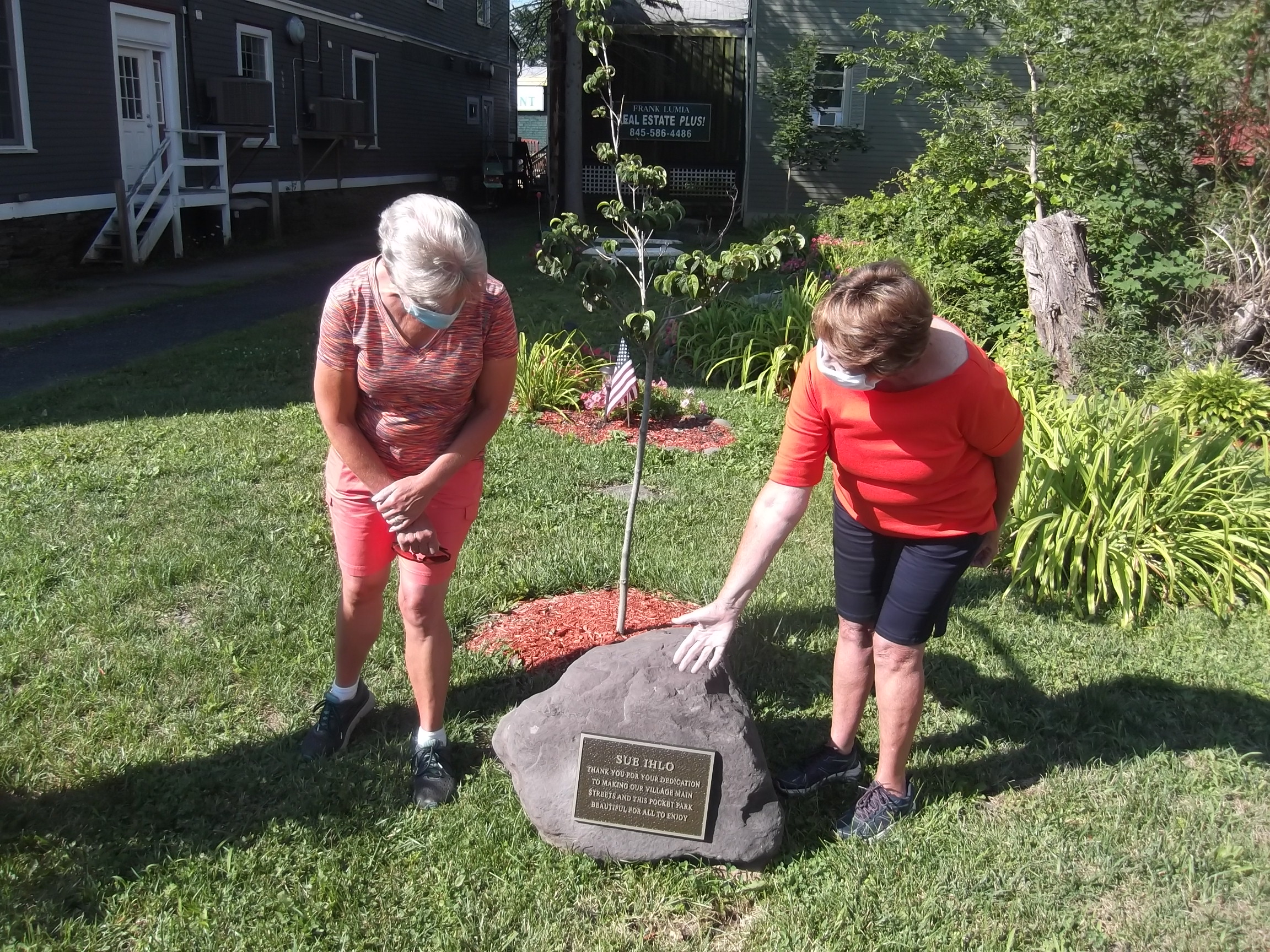 For nearly 30 years Sue Ihlo has been known as the flower lady in Margaretville. With husband Fred and community volunteers, she has raised funds to fill barrels along village streets with bright flowers that have cheered residents, businesspeople and visitors all summer and into the fall. In August 2020, Sue was recognized with a plaque and words of thanks from friends and village trustees in a new pocket park she helped create adjacent to the Binnekill stream on Bridge Street. The Ihlos (long time proprietors of the Cheese Barrel restaurant and gourmet shop), with the support of Nancy Blauer, the village crew and others, removed a dead tree and added a flowering tree, stone benches and perennials to establish a peaceful sitting area. Like the creators of pollinator gardens elsewhere in the village, Sue has contributed color and character to Margaretville.
For nearly 30 years Sue Ihlo has been known as the flower lady in Margaretville. With husband Fred and community volunteers, she has raised funds to fill barrels along village streets with bright flowers that have cheered residents, businesspeople and visitors all summer and into the fall. In August 2020, Sue was recognized with a plaque and words of thanks from friends and village trustees in a new pocket park she helped create adjacent to the Binnekill stream on Bridge Street. The Ihlos (long time proprietors of the Cheese Barrel restaurant and gourmet shop), with the support of Nancy Blauer, the village crew and others, removed a dead tree and added a flowering tree, stone benches and perennials to establish a peaceful sitting area. Like the creators of pollinator gardens elsewhere in the village, Sue has contributed color and character to Margaretville.
Kelley Edkins
Margaretville
Compost and weeds make great gardens!
 The pollinator project reflects my life work -- building beautiful gardens using stone, permaculture methods and compost, creating food for pollinators first and then humans second. I want people to know the value of compost (anything goes that can decompose!) and how to be responsible for their own waste stream. Also to understand the value of “weeds” -- not only that they are food for our pollinators but valuable medicine for humans.
I would like to use this pollinator spiral garden as an outdoor classroom, a prototype design for homeowners, schools and communities to develop their own gardens. I will be offering classes once the plants have taken root and plan to have a Bee Green event with artists, musicians and speakers.
Thanks to Freshtown, Dade Allen, Deanna Kirk, Ruth Golobin, Linda and Harry McCartney, Picnic, Janet Cowan and the Arkville plant market guy for contributions of money, plants, rocks and compost.
The pollinator project reflects my life work -- building beautiful gardens using stone, permaculture methods and compost, creating food for pollinators first and then humans second. I want people to know the value of compost (anything goes that can decompose!) and how to be responsible for their own waste stream. Also to understand the value of “weeds” -- not only that they are food for our pollinators but valuable medicine for humans.
I would like to use this pollinator spiral garden as an outdoor classroom, a prototype design for homeowners, schools and communities to develop their own gardens. I will be offering classes once the plants have taken root and plan to have a Bee Green event with artists, musicians and speakers.
Thanks to Freshtown, Dade Allen, Deanna Kirk, Ruth Golobin, Linda and Harry McCartney, Picnic, Janet Cowan and the Arkville plant market guy for contributions of money, plants, rocks and compost.
Trying something different, for the library
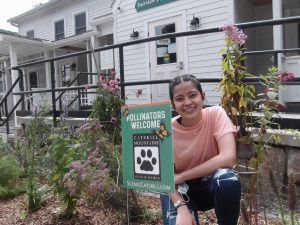 Amaal Bahnas and Sydney Asher, incoming Juniors at Margaretville Central SchooI, are active volunteers with community organizations. Amaal is the student representative on the Fairview Public Library Board of Trustees, and when she was asked to help solicit support for a pollinator garden, she didn’t hesitate. "I don’t have a lot of experience with plants or gardens but it definitely sounded like something cool to try, and maybe attract more people to the library."
Coordinated by board member Ingrid VanderLeeden, the project took two days of hard physical labor. Both Amaal and her friend Sydney helped, along with other volunteers. Now, says Amaal, "I am working on publicity to obtain donations to cover the costs of the work and materials, as well as future additions to the garden, like maybe a bench or a bike rack."
Amaal Bahnas and Sydney Asher, incoming Juniors at Margaretville Central SchooI, are active volunteers with community organizations. Amaal is the student representative on the Fairview Public Library Board of Trustees, and when she was asked to help solicit support for a pollinator garden, she didn’t hesitate. "I don’t have a lot of experience with plants or gardens but it definitely sounded like something cool to try, and maybe attract more people to the library."
Coordinated by board member Ingrid VanderLeeden, the project took two days of hard physical labor. Both Amaal and her friend Sydney helped, along with other volunteers. Now, says Amaal, "I am working on publicity to obtain donations to cover the costs of the work and materials, as well as future additions to the garden, like maybe a bench or a bike rack."
Creating a gathering space
 We cleared the backyard of the Pine Hill Community Center, an unused empty lot with high weeds and uneven ground, used by no one. We will be building flower boxes, planting bee and butterfly-friendly flowers and shrubs and strewing wildflower seeds.
We are looking forward to using the space to teach kids about their fellow creatures and gardening, and also as a meeting space for our weekly “social circle,” a dynamic bunch of older community members. Many of them live alone and really look forward to this company and conversation.
We may well plant a tree in the “new” backyard to remind folks of the reason we established the Center 20 years ago, to celebrate growing and surviving all that’s come our way during the past two decades, and our plans to serve the community during this tough time and into the future.
We cleared the backyard of the Pine Hill Community Center, an unused empty lot with high weeds and uneven ground, used by no one. We will be building flower boxes, planting bee and butterfly-friendly flowers and shrubs and strewing wildflower seeds.
We are looking forward to using the space to teach kids about their fellow creatures and gardening, and also as a meeting space for our weekly “social circle,” a dynamic bunch of older community members. Many of them live alone and really look forward to this company and conversation.
We may well plant a tree in the “new” backyard to remind folks of the reason we established the Center 20 years ago, to celebrate growing and surviving all that’s come our way during the past two decades, and our plans to serve the community during this tough time and into the future.
Gail Lennstrom
Margaretville
A wedding amidst the blooms
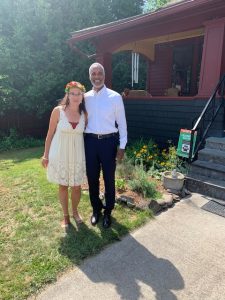 My daughter, Katherine McConnell and fiancé Michael VanLeesten came on June 5 to help me celebrate my birthday and also helped gather rocks to expand my pollinator/rock garden, built by Kelley Edkins. They then exchanged vows in the garden on July 26, 2020. I propose a toast to them as being “pollinators of good projects in the world."
My daughter, Katherine McConnell and fiancé Michael VanLeesten came on June 5 to help me celebrate my birthday and also helped gather rocks to expand my pollinator/rock garden, built by Kelley Edkins. They then exchanged vows in the garden on July 26, 2020. I propose a toast to them as being “pollinators of good projects in the world."
More beauty in Boiceville
 This short film captures the installation of a new pollinator bed featuring a wide variety of native plants including Baptisia (Baptisia australis), a flowering perennial plant that is a member of the legume family (which includes peas and beans) and which is native to Eastern and Central North America. As you walk along the length of the bed, which leads from the top of the driveway down to the Great White Spirit Totem, you can watch butterflies and bees in action as they flit around doing what nature intended. It is all part of our ongoing work to make Brunel Sculpture Garden as beautiful and welcoming for pollinators as it is for people.
- Cynthia Nikitin
Brunel Sculpture Garden, Route 28, Boiceville
This short film captures the installation of a new pollinator bed featuring a wide variety of native plants including Baptisia (Baptisia australis), a flowering perennial plant that is a member of the legume family (which includes peas and beans) and which is native to Eastern and Central North America. As you walk along the length of the bed, which leads from the top of the driveway down to the Great White Spirit Totem, you can watch butterflies and bees in action as they flit around doing what nature intended. It is all part of our ongoing work to make Brunel Sculpture Garden as beautiful and welcoming for pollinators as it is for people.
- Cynthia Nikitin
Brunel Sculpture Garden, Route 28, Boiceville
Look for these pollinator-friendly gardens
on the Catskill Mountain Scenic Byway
and watch for others as they develop!
Andes
Dirty Girl Farm, Rte 28
Andes Library, Main St. (Rte 28)Margaretville
Village Welcome sign, Rte 30 (upper Main St)
Bridge St., across from Freshtown
Fairview Public Library, Walnut St.
Open Eye Theater, Rte 30 (upper Main St.)Middletown
Catskill Mtn. Recreation Center (under development)
Old Stone School (under development)
Fleischmanns
Depot Street and Wagner Ave.
Village parkOlive
Olive Library, Rte 28A
Door Jamb, Rte 28
Brunel Sculpture Garden, Boiceville, Rte 28
Bread Alone, Boiceville, Rte. 28
Argos Animal Hospital, BoicevilleShandaken
Pine Hill Community Center (in progress)
Pine Hill welcome sign
Many businesses, organizations and individuals have supported the Scenic Byway Pollinator Project.
Thanks go to:
Margaretville Rotary Club
Margaretville Telephone Co.
Margaretville Village Garden Fund
Freshtown Market
Picnic
Open Eye Theater
Fleischmanns First
 Chemicals: We have added to our environment hundreds of toxins which harm pollinator nervous systems and are suspected to contribute to Colony Collapse Disorder that has devastated the honeybee population in recent years.
Chemicals: We have added to our environment hundreds of toxins which harm pollinator nervous systems and are suspected to contribute to Colony Collapse Disorder that has devastated the honeybee population in recent years.
 Don’t mow! Allow weeds and wildflowers to grow until they finish flowering to provide much needed nectar for pollinators. Dandelions, for example, are one of the season’s earliest food sources for bees. Milkweeds are an important food source and nursery for the threatened Monarch butterfly. Download a colorful poster of Milkweeds of the Northeast.
Don’t mow! Allow weeds and wildflowers to grow until they finish flowering to provide much needed nectar for pollinators. Dandelions, for example, are one of the season’s earliest food sources for bees. Milkweeds are an important food source and nursery for the threatened Monarch butterfly. Download a colorful poster of Milkweeds of the Northeast. Be aware of public initiatives to help pollinators. The NYS Department of Transportation is considering guidelines for NYS Byways that would adjust mowing schedules and improve pollinator access to flowering plants. The NYC Department of Environmental Protection has revised mowing protocols on city lands in the NYC Watershed to as much as possible avoid cutting weeds and wildflowers before they flower, and to preserve milkweed, which Monarchs in particular rely on for food and habitat. Local officials, too, are urged to consider what they might do to help pollinators in their communities. Click here to view the Mayor’s Monarch Pledge.
Be aware of public initiatives to help pollinators. The NYS Department of Transportation is considering guidelines for NYS Byways that would adjust mowing schedules and improve pollinator access to flowering plants. The NYC Department of Environmental Protection has revised mowing protocols on city lands in the NYC Watershed to as much as possible avoid cutting weeds and wildflowers before they flower, and to preserve milkweed, which Monarchs in particular rely on for food and habitat. Local officials, too, are urged to consider what they might do to help pollinators in their communities. Click here to view the Mayor’s Monarch Pledge.




